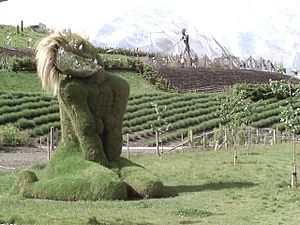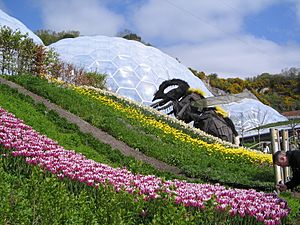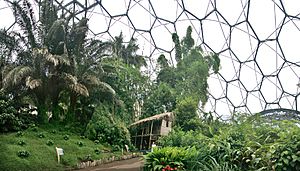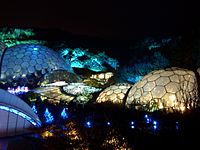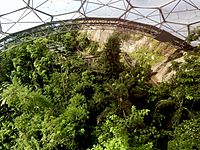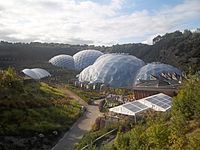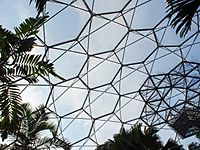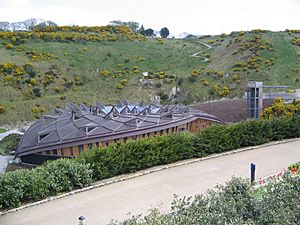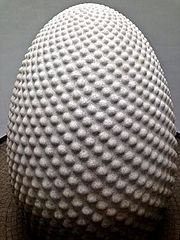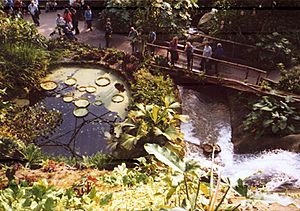Eden Project facts for kids
Quick facts for kids Eden Project |
|
|---|---|
 |
|
| General information | |
| Type | Multiple Greenhouse Complex |
| Architectural style | Inspired by James T. Baldwin's Pillow Dome |
| Location | St Blazey, Cornwall, UK |
| Coordinates | 50°21′43″N 4°44′41″W / 50.36194°N 4.74472°W |
| Completed | May 2000 |
| Opened | 17 March 2001 |
| Technical details | |
| Structural system | Steel frame and thermoplastic |
| Design and construction | |
| Architect | Grimshaw Architects |
| Structural engineer | Anthony Hunt and Associates |
| Services engineer | Arup |
The Eden Project (Cornish: Edenva) is a visitor attraction in Cornwall, England, UK. The project is located in a reclaimed china clay pit, located 2 km (1.2 mi) from the town of St Blazey and 5 km (3 mi) from the larger town of St Austell.
The complex is dominated by two huge enclosures consisting of adjoining domes that house thousands of plant species, and each enclosure emulates a natural biome. The biomes consist of hundreds of hexagonal and pentagonal ethylene tetrafluoroethylene (ETFE) inflated cells supported by Geodesic tubular steel domes. The largest of the two biomes simulates a rainforest environment (and is the largest indoor rainforest in the world) and the second, a Mediterranean environment. The attraction also has an outside botanical garden which is home to many plants and wildlife native to Cornwall and the UK in general; it also has many plants that provide an important and interesting backstory, for example, those with a prehistoric heritage.
There are plans to build an Eden Project North in the seaside town of Morecambe, Lancashire, with a focus on the marine environment.
Contents
History
The clay pit in which the project is sited was in use for over 160 years. In 1981, the pit was used by the BBC as the planet surface of Magrathea in the TV series the Hitchhiker's Guide to the Galaxy. By the mid-1990s the pit was all but exhausted.
The initial idea for the project dates back to 1996, with construction beginning in 1998. The work was hampered by torrential rain in the first few months of the project, and parts of the pit flooded as it sits 15 m (49 ft) below the water table.
The first part of the Eden Project, the visitor centre, opened to the public in May 2000. The first plants began arriving in September of that year, and the full site opened on 17 March 2001.
To counter criticism from environmental groups, the Eden Project committed to investigate a rail link to the site. The rail link was never built, and car parking on the site is still funded from revenue generated from general admission ticket sales, meaning that those who do not drive to the site also pay for the car park.
The Eden Project was used as a filming location for the 2002 James Bond film, Die Another Day. On 2 July 2005 The Eden Project hosted the "Africa Calling" concert of the Live 8 concert series. It has also provided some plants for the British Museum's Africa garden.
In 2005, the Project launched "A Time of Gifts" for the winter months, November to February. This features an ice rink covering the lake, with a small café/bar attached, as well as a Christmas market. Cornish choirs regularly perform in the biomes.
In 2007, the Eden Project campaigned unsuccessfully for £50 million in Big Lottery Fund money for a proposed desert biome. It received just 12.07% of the votes, the lowest for the four projects being considered. As part of the campaign, the Eden Project invited people all over Cornwall to try to break the world record for the biggest ever pub quiz as part of its campaign to bring £50 million of lottery funds to Cornwall.
In December 2009, much of the project, including both greenhouses, became available to navigate through Google Street View.
The Eden Trust revealed a trading loss of £1.3 million for 2012–13, on a turnover of £25.4 million. The Eden Project had posted a surplus of £136,000 for the previous year. In 2014 Eden accounts showed a surplus of £2 million.
The World Pasty Championships have been held at the Eden Project since 2012, an international competition to find the best Cornish pasties and other pasty-type savoury snacks.
The Eden Project is said to have contributed over £1 billion to the Cornish economy. In 2016, Eden became home to Europe's second largest Redwood forest (after the Giants Grove at Birr Castle, Birr Castle Ireland) when forty saplings of coast redwoods, Sequoia sempervirens, which could live for 4,000 years and reach 115 metres in height, were planted there.
The Eden Project received 1,010,095 visitors in 2019.
In December 2020 the project was closed after heavy rain caused several landslips at the site. Managers at the site are assessing the damage and will announce when the project will reopen on the company's website. Reopening became irrelevant as Covid lockdown measures in the UK indefinitely closed the venue from early 2021.
Design and construction
The project was conceived by Tim Smit and designed by Grimshaw Architects and engineering firm Anthony Hunt and Associates (now part of Sinclair Knight Merz). Davis Langdon carried out the project management, Sir Robert McAlpine and Alfred McAlpine did the construction, MERO designed and built the biomes, and Arup was the services engineer, economic consultant, environmental engineer and transportation engineer. Land Use Consultants led the masterplan and landscape design. The project took 2½ years to construct and opened to the public on 17 March 2001.
Site
Layout
Once into the attraction, there is a meandering path with views of the two biomes, planted landscapes, including vegetable gardens, and sculptures that include a giant bee and previously The WEEE Man (removed in 2016), a towering figure made from old electrical appliances and was meant to represent the average electrical waste used by one person in a lifetime.
Biomes
At the bottom of the pit are two covered biomes:
The Tropical Biome, covers 1.56 ha (3.9 acres) and measures 55 m (180 ft) high, 100 m (328 ft) wide, and 200 m (656 ft) long. It is used for tropical plants, such as fruiting banana plants, coffee, rubber and giant bamboo, and is kept at a tropical temperature and moisture level.
The Mediterranean Biome covers 0.654 ha (1.6 acres) and measures 35 m (115 ft) high, 65 m (213 ft) wide, and 135 m (443 ft) long. It houses familiar warm temperate and arid plants such as olives and grape vines and various sculptures.
The Outdoor Gardens represent the temperate regions of the world with plants such as tea, lavender, hops, hemp, and sunflowers, as well as local plant species.
The covered biomes are constructed from a tubular steel (hex-tri-hex) with mostly hexagonal external cladding panels made from the thermoplastic ETFE. Glass was avoided due to its weight and potential dangers. The cladding panels themselves are created from several layers of thin UV-transparent ETFE film, which are sealed around their perimeter and inflated to create a large cushion. The resulting cushion acts as a thermal blanket to the structure. The ETFE material is resistant to most stains, which simply wash off in the rain. If required, cleaning can be performed by abseilers. Although the ETFE is susceptible to punctures, these can be easily fixed with ETFE tape. The structure is completely self-supporting, with no internal supports, and takes the form of a geodesic structure. The panels vary in size up to 9 m (29.5 ft) across, with the largest at the top of the structure.
The ETFE technology was supplied and installed by the firm Vector Foiltec, which is also responsible for ongoing maintenance of the cladding. The steel spaceframe and cladding package (with Vector Foiltec as ETFE subcontractor) was designed, supplied and installed by MERO (UK) PLC, who also jointly developed the overall scheme geometry with the architect, Nicholas Grimshaw & Partners.
The entire build project was managed by McAlpine Joint Venture.
The Core
The Core is the latest addition to the site and opened in September 2005. It provides the Eden Project with an education facility, incorporating classrooms and exhibition spaces designed to help communicate Eden's central message about the relationship between people and plants. Accordingly, the building has taken its inspiration from plants, most noticeable in the form of the soaring timber roof, which gives the building its distinctive shape.
Grimshaw developed the geometry of the copper-clad roof in collaboration with a sculptor, Peter Randall-Page, and Mike Purvis of structural engineers SKM Anthony Hunts. It is derived from phyllotaxis, which is the mathematical basis for nearly all plant growth; the "opposing spirals" found in many plants such as the seeds in a sunflower's head, pine cones and pineapples. The copper was obtained from traceable sources, and the Eden Project is working with Rio Tinto Group to explore the possibility of encouraging further traceable supply routes for metals, which would enable users to avoid metals mined unethically. The services and acoustic, mechanical, and electrical engineering design was carried out by Buro Happold.
Art at The Core
The Core is also home to art exhibitions throughout the year. A permanent installation entitled Seed, by Peter Randall-Page, occupies the anteroom. Seed is a large, 70 tonne egg-shaped stone installation standing some 13 feet (4.0 m) tall and displaying a complex pattern of protrusions that are based upon the geometric and mathematical principles that underlie plant growth.
Environmental aspects
The biomes provide diverse growing conditions, and many plants are on display.
The Eden Project includes environmental education focusing on the interdependence of plants and people; plants are labelled with their medicinal uses. The massive amounts of water required to create the humid conditions of the Tropical Biome, and to serve the toilet facilities, are all sanitised rain water that would otherwise collect at the bottom of the quarry. The only mains water used is for hand washing and for cooking. The complex also uses Green Tariff Electricity – the energy comes from one of the many wind turbines in Cornwall, which were among the first in Europe.
In December 2010 the Eden Project received permission to build a geothermal electricity plant which will generate approx 4MWe, enough to supply Eden and about 5000 households. The project will involve geothermal heating as well as geothermal electricity. Cornwall Council and the European Union came up with the greater part of £16.8m required to start the project. First a well will be sunk nearly 3 miles (4.5 km) into the granite crust underneath Eden. Funding has been secured and drilling is set to begin in summer 2020. Eden co-founder, Sir Tim Smit said, "Since we began, Eden has had a dream that the world should be powered by renewable energy. The sun can provide massive solar power and the wind has been harnessed by humankind for thousands of years, but because both are intermittent and battery technology cannot yet store all we need there is a gap. We believe the answer lies beneath our feet in the heat underground that can be accessed by drilling technology that pumps water towards the centre of the Earth and brings it back up superheated to provide us with heat and electricity".
Other projects
Eden Project North
In 2018, the Eden Project revealed its design for a new version of the project, located on the seafront in Morecambe, Lancashire. There will be biomes shaped like mussels and a focus on the marine environment. There will also be reimagined lidos, gardens, performance spaces, immersive experiences and observatories.
Grimshaw are the architects for the project, which is expected to cost £80 million. The project is a partnership with the Lancashire Enterprise Partnership, Lancaster University, Lancashire County Council and Lancaster City Council. In December 2018, the four local partners agreed to provide £1 million to develop the idea, which will allow the development of an outline planning application for the project. It is expected that there will be 500 jobs created and 8,000 visitors a day to the site.
South Downs
In 2020 Eastbourne Borough Council and the Eden Project announced a joint project to explore the viability of a new Eden site in the South Downs National Park.
Eden Sessions
Since 2002, the Project has hosted a series of musical performances, called the Eden Sessions. Artists have included Amy Winehouse, James Morrison, Muse, Lily Allen, Snow Patrol, Pulp, Brian Wilson, and The Magic Numbers. Oasis were also set to play in the summer of 2008, but the concert was postponed because Noel Gallagher was unable to perform after breaking three ribs in a stage invasion incident several weeks before. The concert was instead played in the summer of 2009.
Performance headliners
- 2008: The Verve, Kaiser Chiefs, and KT Tunstall.
- 2010: Mika, Jack Johnson, Mojave 3, Doves, Paolo Nutini, Mumford & Sons, and Martha Wainwright.
- 2011: The Flaming Lips, Primal Scream, Pendulum, Fleet Foxes, and Brandon Flowers with support from The Horrors, The Go! Team, OK Go, Villagers, and The Bees.
- 2012: Tim Minchin, Example, Frank Turner, Chase & Status, Plan B, Blink-182, Noah and the Whale, and The Vaccines.
- 2013: Kaiser Chiefs, Jessie J, Eddie Izzard, Sigur Rós, and The xx.
- 2014: Dizzee Rascal, Skrillex, Pixar in Concert, Ellie Goulding, and Elbow.
- 2015: Paolo Nutini, Elton John, Paloma Faith, Motörhead, The Stranglers, Spandau Ballet, and Ben Howard.
- 2016: Lionel Richie, Tom Jones, PJ Harvey, Manic Street Preachers, and Jess Glynne.
- 2017: Bastille, Madness, Royal Blood, Blondie, Van Morrison, Bryan Adams, and Foals.
- 2018: Gary Barlow, Massive Attack, A Beautiful Day Out, Ben Howard, Queens of the Stone Age, Jack Johnson, Björk.
- 2019: Stereophonics, Nile Rogers & Chic, The 100th session, Liam Gallagher, The Chemical Brothers, Snow Patrol, Kylie Minogue.
My Chemical Romance were to play the 2020 Eden Sessions in their first UK shows after a six-year hiatus, as part of their reunion tour. The 2020 Sessions were postponed until 2021 due to the COVID-19 pandemic and the closing of the Eden Project.
The 2021 sessions will be headlined by Diana Ross, Lionel Richie, The Script and My Chemical Romance.
In the media
- Robin Kewell (Ed.): Eden: The Inside Story. St Austell n.d.: The Eden Project. DVD.
- The Eden Radio Project. Every Thursday between 5:30 and 7 p.m. on Radio St Austell Bay.
- Die Another Day: Graves' diamond mine
- Trees A Crowd Podcast: An Interview between the Project's head of interpretation, Dr Jo Elworthy, and David Oakes was released on 18 November.
- Andy Day's CBeebies TV show Andy's Aquatic Adventures has had scenes filmed in the Eden Project.
Images for kids
See also
 In Spanish: Proyecto Edén para niños
In Spanish: Proyecto Edén para niños




